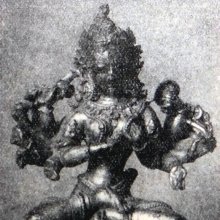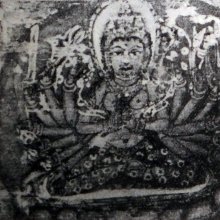Shikshasamuccaya, Śikṣāsamuccaya: 3 definitions
Introduction:
Shikshasamuccaya means something in Hinduism, Sanskrit. If you want to know the exact meaning, history, etymology or English translation of this term then check out the descriptions on this page. Add your comment or reference to a book if you want to contribute to this summary article.
The Sanskrit term Śikṣāsamuccaya can be transliterated into English as Siksasamuccaya or Shikshasamuccaya, using the IAST transliteration scheme (?).
Alternative spellings of this word include Shikshasamuchchaya.
Images (photo gallery)
Languages of India and abroad
Sanskrit dictionary
Source: Cologne Digital Sanskrit Dictionaries: Edgerton Buddhist Hybrid Sanskrit DictionaryŚikṣāsamuccaya (शिक्षासमुच्चय).—name of a work (Śikṣāsamuccaya): Śikṣāsamuccaya 16.1.
Source: Cologne Digital Sanskrit Dictionaries: Monier-Williams Sanskrit-English DictionaryŚikṣāsamuccaya (शिक्षासमुच्चय):—[=śikṣā-samuccaya] [from śikṣā > śikṣ] m. Name of [work]
[Sanskrit to German]
Sanskrit, also spelled संस्कृतम् (saṃskṛtam), is an ancient language of India commonly seen as the grandmother of the Indo-European language family (even English!). Closely allied with Prakrit and Pali, Sanskrit is more exhaustive in both grammar and terms and has the most extensive collection of literature in the world, greatly surpassing its sister-languages Greek and Latin.
See also (Relevant definitions)
Partial matches: Shiksha, Samuccaya.
Full-text (+1264): Sampragraha, Vajradhvajasutra, Ratnamegha, Kalpikaraka, Kudyamula, Mahamegha, Ikshukuttitikam, Vimalakirtinirdesha, Lalitavistara, Palishuddha, Upayanayebhi, Ratnakarandasutra, Dhanashri, Shuradatta, Udayanavatsarajaparipriccha, Brahmajyotirvikriditabhijna, Manjushrivikriditasutra, Lokanathavyakarana, Suparikirtitanamadheyashri, Anantamukhanirharadharani.
Relevant text
Search found 9 books and stories containing Shikshasamuccaya, Śikṣāsamuccaya, Siksasamuccaya, Shiksha-samuccaya, Śikṣā-samuccaya, Siksa-samuccaya; (plurals include: Shikshasamuccayas, Śikṣāsamuccayas, Siksasamuccayas, samuccayas). You can also click to the full overview containing English textual excerpts. Below are direct links for the most relevant articles:
Bodhisattvacharyavatara (by Andreas Kretschmar)
Text Sections 82-83 < [Khenpo Chöga’s Oral Explanations]
Text Section 73 < [Khenpo Chöga’s Oral Explanations]
Life Story Of Dzongsar Khenpo Kunga Wangchuk < [Introduction Text]
The Mahavastu (great story) (by J. J. Jones)
Foreword to the second volume < [Volume II]
Chapter XXX - The second Avalokita-sūtra < [Volume II]
Maha Prajnaparamita Sastra (by Gelongma Karma Migme Chödrön)
Appendix 2 - Two kinds of Pratyekabuddhas < [Chapter XXX - The Characteristics of Prajñā]
Appendix 4 - Triskandha (threefold practice): confession, commemoration, rejoicing < [Chapter XIII - The Buddha-fields]
Blue Annals (deb-ther sngon-po) (by George N. Roerich)
Chapter 2 - The Chapter on Potowa (po to ba) < [Book 5 - The Sovereign Lord (Atiśa)]
Chapter 2b - Kyungpo Naljor disciples (iii): sangs rgyas gnyan ston choskyi shesrab < [Book 9 - Kodrakpa and Niguma]
Chapter 2b - Kyungpo Naljor Disciples (Iv): Sangs Rgyas Ston Pa < [Book 9 - Kodrakpa and Niguma]
A History of Indian Philosophy Volume 2 (by Surendranath Dasgupta)
Part 8 - The Ethics of the Gītā and the Buddhist Ethics < [Chapter XIV - The Philosophy of the Bhagavad-gītā]
The Indian Buddhist Iconography (by Benoytosh Bhattachacharyya)



